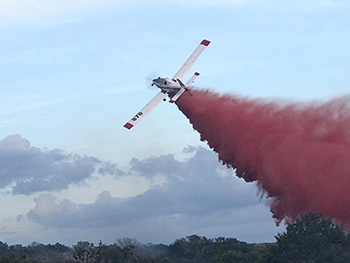April 6, 2021 - Texas A&M Forest Service has opened a single engine air tanker base in Alpine, Texas to assist with wildfire response across the state.
Persistent drought, cured grasses, above normal temperatures and elevated to critical fire weather will produce conditions conducive to increased fire activity from the Big Bend region to the Midland/Odessa area on Tuesday and Wednesday. This same area will likely experience consecutive days of strong drying in vegetation through the end of the week, resulting in critically dry fuels for the weekend.
 In areas east of Childress, San Angelo and Abilene, the fire environment will be less receptive to wildfire activity due to the onset of greening grasses. However, severe to exceptional drought continues for South Texas where cured and above-normal amounts of grass will support fire activity.
In areas east of Childress, San Angelo and Abilene, the fire environment will be less receptive to wildfire activity due to the onset of greening grasses. However, severe to exceptional drought continues for South Texas where cured and above-normal amounts of grass will support fire activity.
During periods of high fire activity, aviation resources are used to support suppression efforts on the ground, aiding in the protection of structures and other valuable resources. Aircraft have responded to multiple fires this year, assisting ground crews with water and retardant drops to slow forward progression of fires.
Aviation resources currently staged in state include one air attack platform and five single engine air tankers.
“This year, we’ve utilized single engine air tankers for response in areas with increased wildfire activity,” said Jared Karns, Texas A&M Forest Service Planning and Preparedness Department Head. “There is potential for a large, fast-moving fire to occur and we want to be prepared by having aircraft in state, ready to respond."
Since January 1, 2021, state and local resources have responded to 1,331 fires that burned a total of 47,402 acres. Aviation resources have flown 39 hours, dropping 4,530 gallons of water and retardant on Texas wildfires so far this year.
According to Les Rogers, Texas A&M Forest Service Chief of Fire Operations, state resources are prepositioned in areas of concern to respond to wildfire activity.
“In addition to the aviation resources now in state, Texas A&M Forest Service has increased the number of equipment and personnel across areas of concern,” said Rogers. “The agency is dedicated to protecting Texas’ citizens and natural resources from wildfire, but it is also crucial that all residents take care to prevent wildfires and to take measures around their home to reduce wildfire risk.”
Successfully preparing for a wildfire requires everyone to take personal responsibility for protecting themselves, their families and their properties.
“It is the responsibility of each individual resident to prepare their home for wildfires,” said Kari Hines, Texas A&M Forest Service Firewise Coordinator. “Every year, there are hundreds of homes that survive wildfires unaided and allow firefighters to operate safely to protect them. And this is due to the landscaping and building choices made long before the fire ever started.”
Texas A&M Forest Service encourages Texans to take the following steps around their homes today to reduce the risk of wildfire:
- Creating defensible space around your home allows for low intensity, slow-burning conditions in the event of a wildfire.
- Within the first 30 feet of your home, use non-flammable landscaping materials. Within the first five feet, water plants, trees and mulch regularly, and consider xeriscaping if you are affected by water restriction.
- A healthy, well-maintained landscape is important to the survival of homes during a wildfire. Make sure your plants are carefully spaced, low growing and free of resins, oils and waxes that burn easily.
- Remove dead vegetation from under the deck of your home and within 10 feet of the house.
- Prune your trees six to 10 feet up from the ground.
“Even simple things such as moving flammable material away from wooden structures like decks and steps, pruning shrubs in front of windows and under mature trees and cleaning out gutters can be done with a limited amount of time if a fire is in the area,” said Hines.
Taking simple steps to help maintain your property could save it during a wildfire. For more information on how to create defensible space around your home, visit https://tfsweb.tamu.edu/ProtectYourHome/.
For current conditions and wildfire outlook, visit the Texas Fire Potential Outlook https://bit.ly/3kemhbG.
Texas A&M Forest Service does not own any aviation resources but instead uses federal aviation contracts through the U.S. Forest Service and Bureau of Land Management for all firefighting aircraft.
Texas A&M Forest Service Contacts:
Texas A&M Forest Service Information Officer, 979-255-0591, information@tfs.tamu.edu
Texas A&M Forest Service Communications Office, 979-458-6606, newsmedia@tfs.tamu.edu








